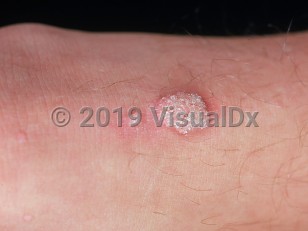Common wart in Infant/Neonate
See also in: External and Internal Eye,AnogenitalAlerts and Notices
Important News & Links
Synopsis

Verruca vulgaris lesions are more prevalent in children aged 4-12 years. The HPV virus is often passed between siblings and may be observed as cyclical infections.
Introduction of HPV into the anogenital area in children can be from several modes of transmission. Vertical transmission has been reported to be responsible for at least 20% of lesions. Horizontal transmission by caregivers in the first days of life is another modality of HPV contamination in newborns. There is also heteroinoculation by affected family members with common warts (verruca vulgaris) and autoinoculation from children who have a cutaneous or oral infection. Nevertheless, perianal and genital warts may be a sign of sexual abuse and must be investigated appropriately.
Codes
B07.8 – Other viral warts
SNOMEDCT:
57019003 – Verruca vulgaris
Look For
Subscription Required
Diagnostic Pearls
Subscription Required
Differential Diagnosis & Pitfalls

Subscription Required
Best Tests
Subscription Required
Management Pearls
Subscription Required
Therapy
Subscription Required
Drug Reaction Data
Subscription Required
References
Subscription Required
Last Updated:01/26/2021
 Patient Information for Common wart in Infant/Neonate
Patient Information for Common wart in Infant/Neonate- Improve treatment compliance
- Reduce after-hours questions
- Increase patient engagement and satisfaction
- Written in clear, easy-to-understand language. No confusing jargon.
- Available in English and Spanish
- Print out or email directly to your patient



